story and photos by Kayte Deioma
The Behind the Scenes tour gives a good historical overview of the Queen Mary. It also introduces you to the original art and craftsmanship built into all the public areas of the ship. I have some time, so I decide to start with this one.
Tour guide Joe Goff meets us at Passenger Information on the Promenade 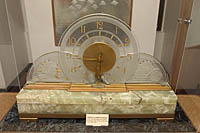 Deck and gives an introduction. He tells us about the ship’s construction and launch and its maiden voyage in May 1936 from South Hampton, England to New York, with a stop in Cherbourg, France. From 1940 to 1944, the ship was drafted into service as a troop ship. After the war she was refurbished and set back into use as a luxury ocean liner in 1947. She was retired in 1967 and sold to the City of Long Beach, where she arrived in December after crossing the Atlantic 1001 times. After being remodeled as a hotel and exhibit, the ship opened up to the public in her current location in 1971 .
Deck and gives an introduction. He tells us about the ship’s construction and launch and its maiden voyage in May 1936 from South Hampton, England to New York, with a stop in Cherbourg, France. From 1940 to 1944, the ship was drafted into service as a troop ship. After the war she was refurbished and set back into use as a luxury ocean liner in 1947. She was retired in 1967 and sold to the City of Long Beach, where she arrived in December after crossing the Atlantic 1001 times. After being remodeled as a hotel and exhibit, the ship opened up to the public in her current location in 1971 .
In the Promenade Gallery, our guide introduces us to Kenneth Shoesmith’s 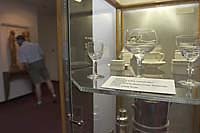 painting,Madonna of the Atlantic, which used to hang in the first class sitting room. The small Gallery exhibits a diverse collection of artwork, custom furnishings, fabrics, Art Deco ornamentation, silver service, down to the Stuart Crystal stemware used in the first class dining room.
painting,Madonna of the Atlantic, which used to hang in the first class sitting room. The small Gallery exhibits a diverse collection of artwork, custom furnishings, fabrics, Art Deco ornamentation, silver service, down to the Stuart Crystal stemware used in the first class dining room.
The tour proceeds through the Promenade shopping area, past the Bakery, which used to be the first class children’s playroom and into the Observation 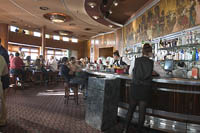 Bar and Cocktail Lounge which gives a view out to the bow of the ship. According to Joe, the Observation Bar was closed during rough weather “because the bow of the ship was known to plunge below the water line.” In the Observation Bar, the bar itself is along the bulkhead. Alfred R. Thomson’s mural, The Royal Jubilee Week is on the wall above. A highly sculpted ornamental balustrade by Austen Compton Roberts runs throughout the entire bar. The Observation Bar is a popular movie location, recently seen in The Aviator with Leonardo DiCaprio.
Bar and Cocktail Lounge which gives a view out to the bow of the ship. According to Joe, the Observation Bar was closed during rough weather “because the bow of the ship was known to plunge below the water line.” In the Observation Bar, the bar itself is along the bulkhead. Alfred R. Thomson’s mural, The Royal Jubilee Week is on the wall above. A highly sculpted ornamental balustrade by Austen Compton Roberts runs throughout the entire bar. The Observation Bar is a popular movie location, recently seen in The Aviator with Leonardo DiCaprio.
We explore the Queens Salon, weaving between stacked chairs awaiting the next banquet event. This was formerly the First Class Main Lounge, where 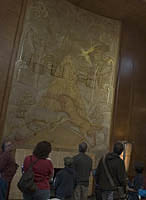 passengers would listen to music and socialize. Three decks high, sunlight comes into the Salon from the Sports Deck above, reflecting off the three different kinds of “beautiful woods” that panel the ceiling, walls and pillars. The artwork has a musical theme to reflect the room’s intended purpose, with etchings around the mirrors and Maurice Lambert’s reliefs entitledSymphony over the doorway and main stage. On the forward wall, a carved gesso panel tinted silver and gold by Alfred J. Oakley and Gilbert Bayes entitled Unicorns in Battle, is the second largest piece of artwork on the ship. In the evenings, the rug would be rolled up exposing the oak parquet floors and the First Class Lounge became a ballroom.
passengers would listen to music and socialize. Three decks high, sunlight comes into the Salon from the Sports Deck above, reflecting off the three different kinds of “beautiful woods” that panel the ceiling, walls and pillars. The artwork has a musical theme to reflect the room’s intended purpose, with etchings around the mirrors and Maurice Lambert’s reliefs entitledSymphony over the doorway and main stage. On the forward wall, a carved gesso panel tinted silver and gold by Alfred J. Oakley and Gilbert Bayes entitled Unicorns in Battle, is the second largest piece of artwork on the ship. In the evenings, the rug would be rolled up exposing the oak parquet floors and the First Class Lounge became a ballroom.
The mirrors have a thin layer of peach tinted glass over them for the benefit of passengers feeling seasick and looking green. “Only in first class” Joe explains, “could you look in the mirror, see a healthier tan complexion, and hopefully feel just a little bit better.”
Our tour moves on to the Royal Salon, the first class men’s only smoking lounge. The walls are paneled with English pollard oak, also known as tiger oak because of patterns in the wood that resemble a giant tiger’s face.
Then up the stairs to the Sun Deck and into the Veranda Grill, which was the most exclusive restaurant on board. Reservations had to be made at the time the cruise was booked. First class passengers could only eat one meal in the Veranda Grill per cruise unless, of course, you were the Duke and Duchess of Windsor who ate here every night when they were on board. In the evening it would become the Starlight Roof Nightclub. The murals and entire room design were created by stage designer and artist, Doris Zinkheisen.
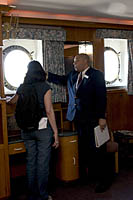 Next Joe takes us down into the passenger accommodations to visit a first class premier suite with a bedroom, two bathrooms, a large sitting area, maid’s quarters and luggage storage. In the bathroom, in addition to four knobs on the tub faucet, two for salt water and two for fresh water, red and green call buttons on the tub could call a men’s or lady’s bath steward to scrub your back or hand you your towel from the heated towel rack.
Next Joe takes us down into the passenger accommodations to visit a first class premier suite with a bedroom, two bathrooms, a large sitting area, maid’s quarters and luggage storage. In the bathroom, in addition to four knobs on the tub faucet, two for salt water and two for fresh water, red and green call buttons on the tub could call a men’s or lady’s bath steward to scrub your back or hand you your towel from the heated towel rack.
The last stop on the Behind the Scenes Tour is the first class swimming pool 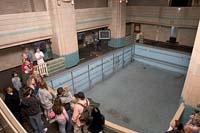 which had separate pool hours for men and women. While first class passengers enjoyed their afternoon tea, third class passengers had one hour to use the pool. “Afterwards the pool was drained, scrubbed down and refilled with warm saltwater,” Joe tells us. The second class passengers had their own pool which is no longer on the ship.
which had separate pool hours for men and women. While first class passengers enjoyed their afternoon tea, third class passengers had one hour to use the pool. “Afterwards the pool was drained, scrubbed down and refilled with warm saltwater,” Joe tells us. The second class passengers had their own pool which is no longer on the ship.
From here we have to decide if we want to proceed immediately to the WWII Tour or take a break for lunch and then take the Haunted Encounters tour. The WWII Tour takes place mostly outside, not optimal for a rainy day. We opt to grab a sandwich at the Sun Deck Deli before getting a more “close-up and personal” tour of the haunted halls than the special effects of the Ghosts and Legends Show.
